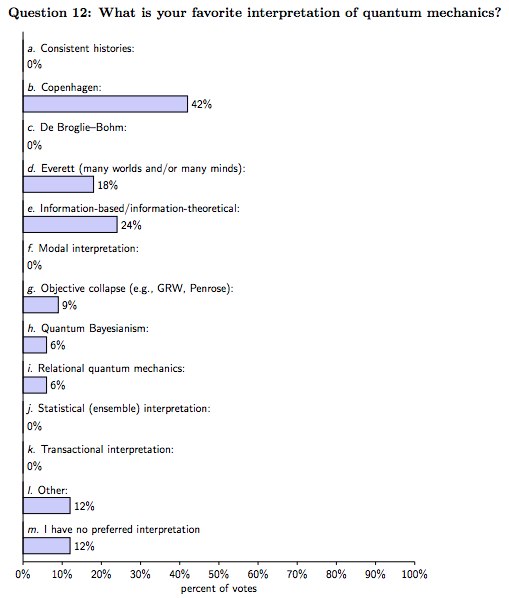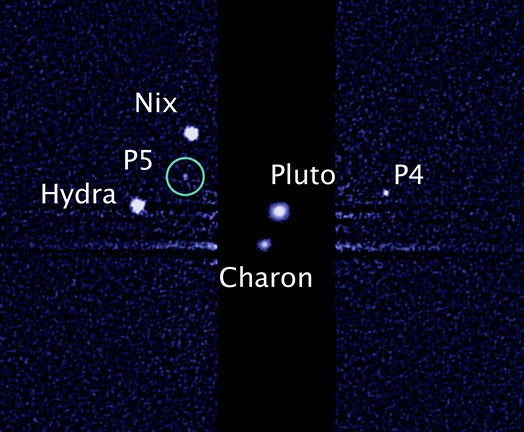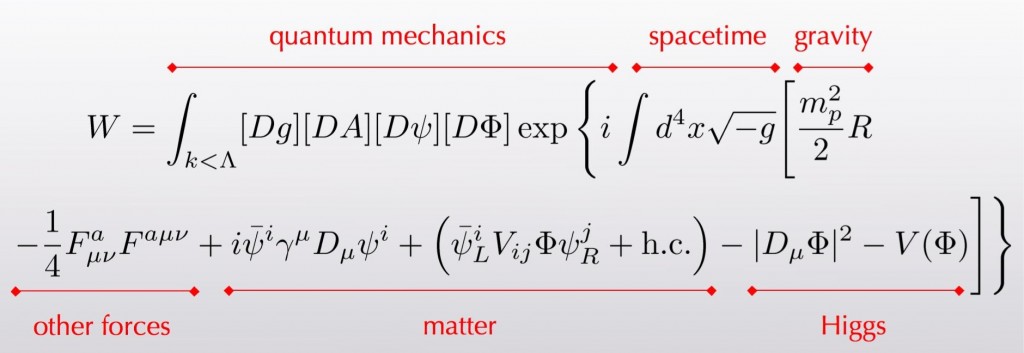Scientists don’t always agree with each other. Yes, I know; shocking but true. In cases of collegial disagreement, it’s often fun to quantify the extent of opinion by gathering a collection of experts and taking a poll. Inevitably some killjoy will loudly grumble that “scientific questions aren’t decided by voting!”, but that misses the point. A poll of scientists isn’t meant to decide questions, it’s meant to collect data — mapping out the territory of opinion among people who have spent time and effort thinking carefully about the relevant questions.
There’s been a bit of attention given recently to one such poll, carried out by Maximilian Schlosshauer�, Johannes Kofler, and Anton Zeilinger at a quantum foundations meeting (see John Preskill at Quantum Frontiers, Swans on Tea). The pollsters asked a variety of questions, many frustratingly vague, which were patiently answered by the 33 participants.
This plot gives the money shot, as they say in Hollywood:

It’s a histogram of the audience’s “favorite” interpretation of quantum mechanics. As we see, among this expert collection of physicists, philosophers, and mathematicians, there is not much of a consensus. A 42% percent plurality votes for the “Copenhagen” interpretation, while the others are scattered over a handful of alternatives.
I’ll go out on a limb to suggest that the results of this poll should be very embarrassing to physicists. Not, I hasten to add, because Copenhagen came in first, although that’s also a perspective I might want to defend (I think Copenhagen is completely ill-defined, and shouldn’t be the favorite anything of any thoughtful person). The embarrassing thing is that we don’t have agreement.
Think about it — quantum mechanics has been around since the 1920’s at least, in a fairly settled form. John von Neumann laid out the mathematical structure in 1932. Subsequently, quantum mechanics has become the most important and best-tested part of modern physics. Without it, nothing makes sense. Every student who gets a degree in physics is supposed to learn QM above all else. There are a variety of experimental probes, all of which confirm the theory to spectacular precision.
And yet — we don’t understand it. Embarrassing. To all of us, as a field (not excepting myself).
I’m sitting in a bistro at the University of Nottingham, where I gave a talk yesterday about quantum mechanics. I put it this way: here in 2013, we don’t really know whether objective “wave function collapse” is part of reality (as the poll above demonstrates). We also don’t know whether, for example, supersymmetry is part of reality. Wave function collapse has been a looming problem for much longer, and is of much wider applicability, than the existence of supersymmetry. Yet the effort that is put into investigating the two questions is extremely disproportionate.
Not that we should be spending as much money trying to pinpoint a correct understanding of quantum mechanics as we do looking for supersymmetry, of course. The appropriate tools are very different. We won’t know whether supersymmetry is real without performing very costly experiments. For quantum mechanics, by contrast, all we really have to do (most people believe) is think about it in the right way. No elaborate experiments necessarily required (although they could help nudge us in the right direction, no doubt about that). But if anything, that makes the embarrassment more acute. All we have to do is wrap our brains around the issue, and yet we’ve failed to do so.
I’m optimistic that we will, however. And I suspect it will take a lot fewer than another eighty years. The advance of experimental techniques that push the quantum/classical boundary is forcing people to take these issues more seriously. I’d like to believe that in the 21st century we’ll finally develop a convincing and believable understanding of the greatest triumph of 20th-century physics.



